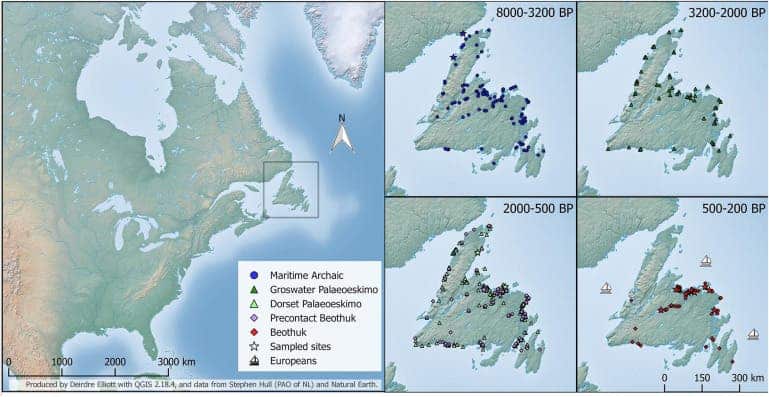Northeastern Canada has been settled again and again by distinct cultural groups, archaeological evidence suggests. A new paper reports that at least two of these groups were completely unrelated, adding further support to the theory that these people had distinct population histories.

The settlement history of Newfoundland, encompassing occupations by at least three distinct cultural groups: Maritime Archaic, Dorset Palaeoeskimo, and Beothuk.
Image credits Deirdre Elliott, Stephen Hull.
People have been living in Newfoundland, on Canada’s northeastern edge, ever since the Last Glacial Maximum subsided and ice caps retreated from the region roughly 10.000 years ago. Archaeological work has revealed that the area has seen quite a lot of newcomers in the meantime. Distinct cultural groups inhabiting the region at least three different times, with a possible hiatus between 2,000 and 3,000 years ago.
Two of the groups that reached Newfoundland are known as the Maritime Archaic and Beothuk, and according to a team of researchers led by Ana Duggan of McMaster University, these two groups were completely unrelated.
Ancient melting pot
Archaeological findings couldn’t decisively establish the relationship between the Maritime Archaic and the Beothuk. So the team requested permission from current-day indigenous communities to retrieve DNA samples from 74 ancient remains strewn about the island of Newfoundland. After receiving the green-light, the team collected genetic material from tiny amounts of bone or teeth, as available.
The sample set included a Maritime Archaic subadult found in the L’Anse Amour burial mound, the oldest known burial mound in North America and one of the first manifestations of the Maritime Archaic tradition. The individual died more than 7,700 years ago. Most of the Beothuk samples came from the area around Notre Dame Bay, where the group retreated as a response to European expansion in the region, and the source-individuals were usually under 300 years old.
Analysis of mitochondrial DNA in the samples provided evidence that the two groups were unrelated. The two groups didn’t share a common maternal ancestor in the recent past, but rather one that coalesces sometime in the more distant past — meaning they split off a long time ago, and had developed into unrelated groups by the time they came to the island.
“Our paper suggests, based purely on mitochondrial DNA, that the Maritime Archaic were not the direct ancestors of the Beothuk and that the two groups did not share a very recent common ancestor,” Duggan says.
“This in turn implies that the island of Newfoundland was populated multiple times by distinct groups.”
Duggan says the research showcases the “extremely rich” dynamics of early people in the area. The fact that the Maritime Archaic people aren’t the direct ancestors of the Beothuk means there had to be multiple independent arrivals on the island, and that the arivees then settled the land for many generations.
“This record suggests abandonment, severe constriction, or local extinction followed by subsequent immigrations from single or multiple source populations, but the specific dynamics and the cultural and biological relationships, if any, among these successive peoples remain enigmatic,” the paper notes.
The paper “Genetic Discontinuity between the Maritime Archaic and Beothuk Populations in Newfoundland, Canada” has been published in the journal Current Biology









